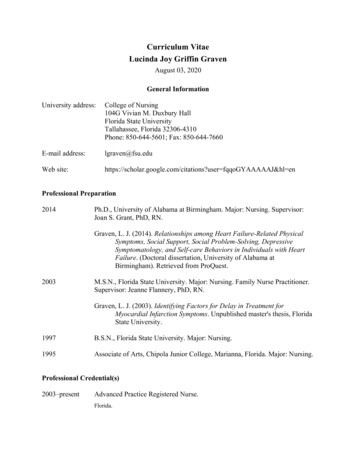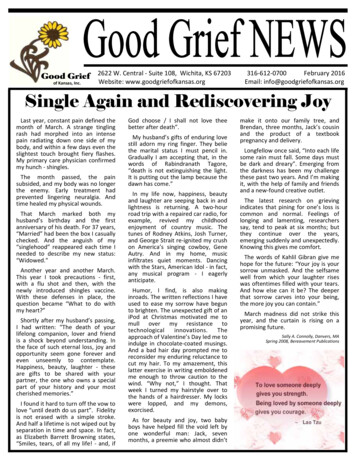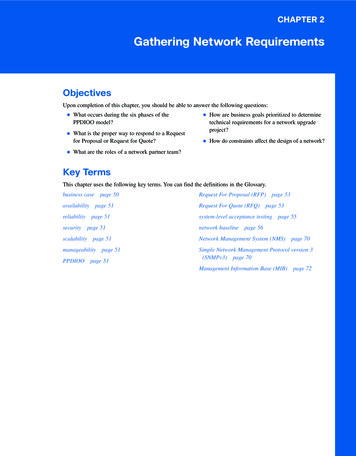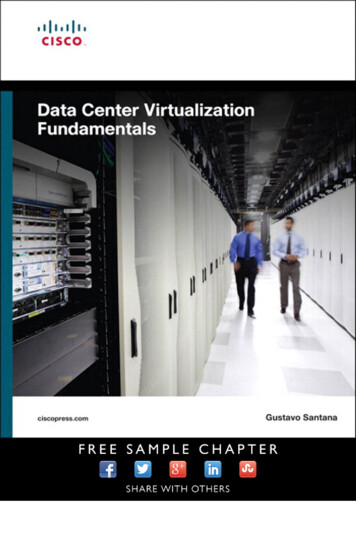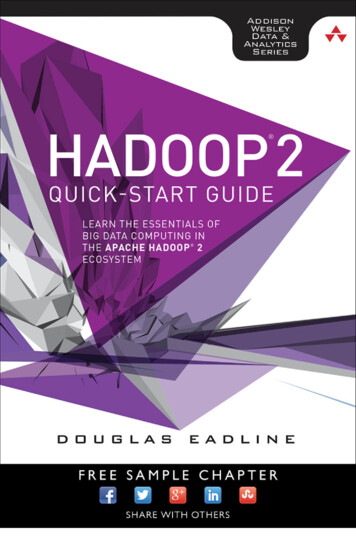
Transcription
The Joy of UX
The Joy of UXUser Experience and InteractiveDesign for DevelopersDavid PlattBoston Columbus Indianapolis New York San Francisco Amsterdam Cape TownDubai London Madrid Milan Munich Paris Montreal Toronto Delhi Mexico CitySão Paulo Sidney Hong Kong Seoul Singapore Taipei Tokyo
Many of the designations used by manufacturers and sellers to distinguish their products areclaimed as trademarks. Where those designations appear in this book, and the publisher was awareof a trademark claim, the designations have been printed with initial capital letters or in all capitals.The author and publisher have taken care in the preparation of this book, but make no expressedor implied warranty of any kind and assume no responsibility for errors or omissions. No liability isassumed for incidental or consequential damages in connection with or arising out of the use ofthe information or programs contained herein.For information about buying this title in bulk quantities, or for special sales opportunities (whichmay include electronic versions; custom cover designs; and content particular to your business,training goals, marketing focus, or branding interests), please contact our corporate salesdepartment at corpsales@pearsoned.com or (800) 382-3419.For government sales inquiries, please contact governmentsales@pearsoned.com.For questions about sales outside the U.S., please contact intlcs@pearson.com.Visit us on the Web: informit.com/awLibrary of Congress Cataloging-in-Publication DataNames: Platt, David S., author.Title: The joy of UX : User Experience and interactive design for developers/ David Platt.Description: Boston : Addison-Wesley, [2016] Includes index.Identifiers: LCCN 2016009039 ISBN 9780134276717 (pbk. : alk. paper) ISBN013427671X (pbk. : alk. paper)Subjects: LCSH: User interfaces (Computer systems) Human-computerinteraction. Computer software—Development.Classification: LCC QA76.9.U83 P54 2016 DDC 005.4/37—dc23LC record available at https://lccn.loc.gov/2016009039Copyright 2016 Pearson Education, Inc.All rights reserved. Printed in the United States of America. This publication is protectedby copyright, and permission must be obtained from the publisher prior to any prohibitedreproduction, storage in a retrieval system, or transmission in any form or by any means, electronic,mechanical, photocopying, recording, or likewise. For information regarding permissions, requestforms and the appropriate contacts within the Pearson Education Global Rights & PermissionsDepartment, please visit www.pearsoned.com/permissions/.ISBN-13: 978-0-13-427671-7ISBN-10: 0-13-427671-XText printed in the United States on recycled paper at RR Donnelley in Crawfordsville, Indiana.First printing, May 2016PublisherMark L. TaubExecutive EditorLaura LewinDevelopment EditorMichael ThurstonManaging EditorSandra SchroederFull-Service ProductionManagerJulie B. NahilCopy EditorBarbara WoodIndexerInfodex Indexing ServicesProofreaderLinda BegleyTechnical ReviewersLars Athle LarsenGregg TompkinsMoshe RaabEditorial AssistantOlivia BasegioCover DesignerChuti PrasertsithCompositorShepherd, Inc.
To all my students, from whom I learn so much.
This page intentionally left blank
ContentsForewordAbout the AuthorxiiixvIntroduction: UX Rules the Roost1Your Biggest Advantage2UX Is Not Fonts and Colors2Fundamental Example4The Three Fundamental Corollaries7Example: Save Me?8Bake UX In from the Beginning10Why Developers Don’t Consider UX11Our Projects Are Low-Level, So UX Doesn’t Matter11Marketing Decides Our UX11We Have a UX Group That Does That Stuff12UX Is for the Beret-Heads12Where to Get the Skills12You Can Do This13This Book’s Web Site15And Here We Go . . .151 Personas17Putting a Face on the User18Creating the Simplest Persona18Adding Detail22The Big Three Details22Business Interaction23Hardware and Software23Grokkability Items24Personality Cues25Personal Essay25Using Personas27Succeeding with Personas28
viiiCONTENTS2 What Do Users Want? (and Where, and When,and Why?)31We’re Not Programming Yet32But Users Don’t Know What They Want!32Finding Users to Examine34Interviewing Users35Observing Users37Explaining It to the Geeks39Storytelling41Writing Stories42Interview and Story Example433 Sketching and Prototyping47Prototyping: The Wrong Way to Start48Starting with a Good Sketch49Mockup Tool Example: Balsamiq51Showing Interaction through a Storyboard61Demonstrating through Live Action644 Testing on Live Users67Testing Constantly, Testing Throughout68Why Isn’t Testing Done?69Start Testing Early72What We Learn from UX Testing72Finding Test Users73Compensating Test Users75Test Area Design and Setup75Using a Moderator76Task Design and Description77Watching and Debriefing78User Testing Example79The Last Word in Usability Testing87
CONTENTS5 Telemetry and Analytics89The Guessing Game Era90Telemetry as a Solution91Evolution of Telemetry93Permission and Privacy96Selecting a Telemetry Provider98What to Track99Telemetry Example100Suggestions for Telemetry Today104Getting Telemetry Wrong1056 Security and Privacy107Everything’s a Trade-off108Users Are Human108What Users Really Care About109The Hassle Budget110Respect Your Users’ Hassle Budget112A Widespread, Real-Life, Hassle Budget Workaround113Case Study: Amazon.com116Securing Our Applications121Understand Our Users’ Hassle Budget121Start with Good Defaults122Decide, Don’t Ask124Use Your Persona and Story Skills to Communicate127Strengthen Your Stories with Data127Cooperate with Other Security Layers128Read a Good Book129Bury the Hatchet129The Last Word on Security1297 Making It Just Work131The Key to Everything132Start with Good Defaults132ix
xCONTENTSRemember Everything That You Should136Speak Your Users’ Language137Don’t Make Users Do Your Work139Don’t Let Edge Cases Dictate the Mainstream141Don’t Make the User Think142Don’t Confirm144Do Undo146Non-Undoable Operations148Have the Correct Configurability152Lead the Witness1548 Case Study: Commuter Rail Mobile App157Pity the Poor Commuter158Current State of the Art158Step 1: Who?162Step 2: What (and When, and Where, and Why)?166Story 1169Story 2169Story 3170Story 4170Step 3: How?170Step 4: Try It Out173Step 5: Telemetry Plan179Step 6: Security and Privacy Plan180Step 7: Make It Just Work181Start with Good Defaults181Remember Everything That You Should181Speak Your Users’ Language181Don’t Make Users Do Your Work181Don’t Let Edge Cases Dictate the Mainstream182Don’t Make the User Think182Don’t Confirm182Do Undo182
CONTENTSHave the Correct Configurability182Lead the Witness1829 Case Study: Medical Patient Portal183A Good First Try184Current State of the Art184Step 1: Who?193Step 2: What (and When, and Where, and Why)?196Story 1196Story 2197Story 3198Step 3: How?198Step 4: Try It Out202A Quick Speculation: Health Coach Mobile App206Step 5: Telemetry Plan207Step 6: Security and Privacy Plan209Step 7: Make It Just Work211Start with Good Defaults211Remember Everything That You Should211Speak Your Users’ Language211Don’t Make Users Do Your Work211Don’t Let Edge Cases Dictate the Mainstream212Don’t Make the User Think212Don’t Confirm212Do Undo212Have the Correct Configurability212Lead the Witness212Index213xi
This page intentionally left blank
ForewordOccasionally you meet a teacher who’s so enthusiastic about what he teaches that the enthusiasm rubs off almost contagiously. David is that rare kind of teacher. I’ve seen it live in his classesand with his students. I see that same love and enthusiasm in The Joy of UX, and I know youwill too.I have to confess: I’m the wrong person to write this foreword. I may have the world’s worstnatural sense of user interface design. But over the years, and especially with the assistance ofDavid Platt, I’ve produced some pretty great software. The software produced by the teams I’veled has generated billions in revenue and has been used by millions of people.Incredibly, I’ve also learned to enjoy creating breathtaking UX. I once thought building a greatuser experience was a tedious process, primarily about colors and fonts and something to dowith the golden ratio. Far more critical are the tools and techniques David teaches: empathyfor your user, hypothesis testing, and iterating on those hypotheses by watching how usersinteract with the software. Put another way: fall in love with your users and prioritize theirhappiness.When I finally embraced the techniques and processes David writes about in this book, I didn’tjust end up creating delightful user experiences. It also had a profound effect on how I developsoftware. At the heart of a great user experience is empathy for the user. Developing this empathy requires a true understanding of who your users are. This changed my entire orientationfrom thinking about what (What code should I write? What language should I use? What is thetechnology?) to thinking in terms of who and why. This requires hard work and hard thinking.You must leave your keyboard behind and adventure out into the world. You must meet thepeople who are using (or will use) your software and talk to them. They will surprise you. Theywill defy expectations. After you build, you must go back to them and continuously developyour relationship and understanding of how they think, what motivates them, and discover the“why” behind what drives them.I also learned to take a much more iterative approach to software development. “I should buildfeature ‘X’” turns into a hypothesis that needs to be validated—by the customer. Applying auser-centric process to all feature decisions made my process leaner than just using a Kanbanboard or Scrum. To determine what to build next, we must determine what will have the highest impact on the user’s experience.
xivFOREWORDThese techniques are vital today, especially when building mobile applications. End users havetremendous choices. They are fickle. If they don’t grok your application immediately, they’llnever touch it again.You can delight your users by incorporating David’s advice into your workflow. Get inside yourusers’ heads, develop a deep understanding and empathy for their lives, test your assumptions,and discover “why.”—Keith BallingerVice President of Product at Xamarin
About the AuthorDavid Platt teaches User Experience Engineering at Harvard University Extension School andat companies all over the world. He’s the author of 12 programming books, including Why Software Sucks (Addison-Wesley, 2006) and Introducing Microsoft .NET (Microsoft Press, 2003). Whenhe finishes working, he spends his free time working some more. When readers ask, “Did youreally tape down two of your daughter’s fingers so she’d learn how to count in octal?”, he justsmiles. Microsoft named him a Software Legend in 2002. Dave lives in Ipswich, Massachusetts.You can contact him at www.joyofux.com.
This page intentionally left blank
IntroductIonUX RUles the RoostUser experience (UX) is the primary driver ofcompetitive advantage in software today. Programswith bad UX just won’t sell, nor will the hardware orservices they are supposed to enable.Good UX is not that hard, but it requires you to thinkin new ways. This book shows you how, step by step,with examples along the way.
2IntroductIonUX RULES THE ROOSTYour Biggest AdvantageUX is the primary driver of competitive advantage in the software industry today. Whether youdesign and sell software as a product (Microsoft), or use it to sell hardware (Apple) or services(UPS), the user experience of your software is absolutely critical.Just as smoking in public places was once common, it was once common to force users tocontort themselves into five-dimensional hyper-pretzels to match their software—to become“computer literate,” in the term of that day. UX guru Alan Cooper wrote that a computer-literateuser is one who “has been hurt so often that the scar tissue is so thick that he no longer feelsthe pain.” Users once accepted this as the price of getting their computing jobs done. Theywon’t do that anymore.Remember when Apple was left for dead in 1997, kept alive solely by a cash infusion fromMicrosoft so that Microsoft could claim it wasn’t a monopoly? How did Apple become the mostvaluable company ever seen on the face of the planet? By turning out great UX, for which itscustomers pay premium prices. That’s how important UX has become.UX is critical to the enterprise sector as well. In December of 2014, Avon had to kill a new versionof its order management software. The Wall Street Journal reported that the company’s salesforce of independent reps “found the new system so burdensome and disruptive to their dailyroutine that many left Avon.”Even IBM, the stodgiest of stodgy companies, recently announced that it was spending 100million on its UX consulting business, opening ten new labs worldwide and hiring 1,000 newworkers.Whatever you are doing, and whomever you are doing it for, you need an excellent UX. It’s notoptional anymore.UX Is Not Fonts and ColorsToo many developers and managers think that UX design is selecting colors and fonts andbutton radii. Nothing could be further from the truth. The rounded window corners and cutesyanimations are the last and least important pieces of the UX. My fellow Software Legend BillyHollis calls that stuff “decoration, not design.”What’s the difference between user experience (UX) and user interface (UI)? As is always thecase when specific meanings are forced onto generic words, it is difficult to find any two writerswho agree on what they mean. Throughout this book, I will use UI to mean the decoration function that is the very last thing you do to a piece of software. I will use UX in the meaning published by Jakob Nielsen and Donald Norman, who wrote that “user experience encompassesall aspects of the end-user’s interaction with the company, its services, and its products.” That
US IS NOT FONTS AND COLORSmea
UX RUles the Roost User experience (UX) is the primary driver of competitive advantage in software today. Programs with bad UX just won’t sell, nor will the hardware or services they are supposed to enable. Good UX is not that hard, but it requires you to think in new ways. This book shows you how, step by step, with examples along the way.






